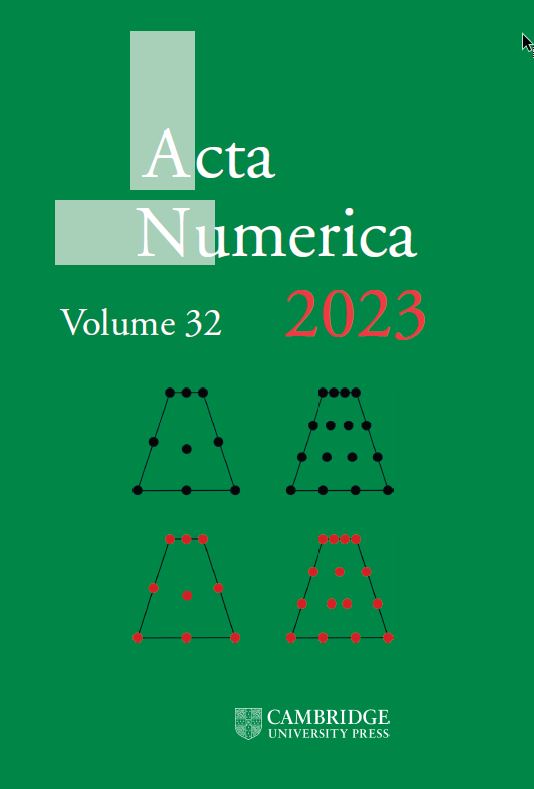Numerical analysis of hemivariational inequalities in contact mechanics
IF 11.3
1区 数学
Q1 MATHEMATICS
引用次数: 81
Abstract
Contact phenomena arise in a variety of industrial process and engineering applications. For this reason, contact mechanics has attracted substantial attention from research communities. Mathematical problems from contact mechanics have been studied extensively for over half a century. Effort was initially focused on variational inequality formulations, and in the past ten years considerable effort has been devoted to contact problems in the form of hemivariational inequalities. This article surveys recent development in studies of hemivariational inequalities arising in contact mechanics. We focus on contact problems with elastic and viscoelastic materials, in the framework of linearized strain theory, with a particular emphasis on their numerical analysis. We begin by introducing three representative mathematical models which describe the contact between a deformable body in contact with a foundation, in static, history-dependent and dynamic cases. In weak formulations, the models we consider lead to various forms of hemivariational inequalities in which the unknown is either the displacement or the velocity field. Based on these examples, we introduce and study three abstract hemivariational inequalities for which we present existence and uniqueness results, together with convergence analysis and error estimates for numerical solutions. The results on the abstract hemivariational inequalities are general and can be applied to the study of a variety of problems in contact mechanics; in particular, they are applied to the three representative mathematical models. We present numerical simulation results giving numerical evidence on the theoretically predicted optimal convergence order; we also provide mechanical interpretations of simulation results.接触力学中半变分不等式的数值分析
接触现象出现在各种工业过程和工程应用中。由于这个原因,接触力学已经引起了研究界的广泛关注。接触力学的数学问题已经被广泛研究了半个多世纪。最初的努力集中在变分不等式公式上,在过去的十年中,相当多的努力致力于半变分不等式形式的接触问题。本文综述了接触力学中出现的半分不等式研究的最新进展。在线性应变理论的框架下,我们关注弹性和粘弹性材料的接触问题,并特别强调它们的数值分析。我们首先介绍了三个代表性的数学模型,它们描述了在静态,历史依赖和动态情况下与基础接触的可变形体之间的接触。在弱公式中,我们考虑的模型会导致各种形式的半变分不等式,其中未知量要么是位移场,要么是速度场。在此基础上,我们引入并研究了三个抽象的半变不等式,给出了它们的存在唯一性结果,并给出了数值解的收敛性分析和误差估计。抽象半变分不等式的结果具有普遍性,可应用于接触力学中各种问题的研究;特别地,将它们应用于三个具有代表性的数学模型。给出了数值模拟结果,为理论预测的最优收敛阶提供了数值证据;我们还提供了模拟结果的力学解释。
本文章由计算机程序翻译,如有差异,请以英文原文为准。
求助全文
约1分钟内获得全文
求助全文
来源期刊

Acta Numerica
MATHEMATICS-
CiteScore
26.00
自引率
0.70%
发文量
7
期刊介绍:
Acta Numerica stands as the preeminent mathematics journal, ranking highest in both Impact Factor and MCQ metrics. This annual journal features a collection of review articles that showcase survey papers authored by prominent researchers in numerical analysis, scientific computing, and computational mathematics. These papers deliver comprehensive overviews of recent advances, offering state-of-the-art techniques and analyses.
Encompassing the entirety of numerical analysis, the articles are crafted in an accessible style, catering to researchers at all levels and serving as valuable teaching aids for advanced instruction. The broad subject areas covered include computational methods in linear algebra, optimization, ordinary and partial differential equations, approximation theory, stochastic analysis, nonlinear dynamical systems, as well as the application of computational techniques in science and engineering. Acta Numerica also delves into the mathematical theory underpinning numerical methods, making it a versatile and authoritative resource in the field of mathematics.
 求助内容:
求助内容: 应助结果提醒方式:
应助结果提醒方式:


